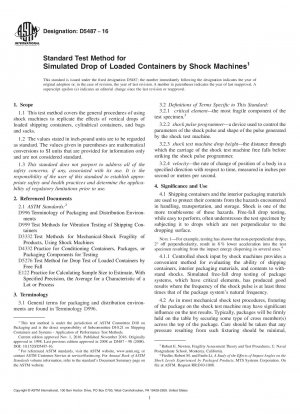ASTM D5487-16
Standard Test Method for Simulated Drop of Loaded Containers by Shock Machines
- Standard No.
- ASTM D5487-16
- Release Date
- 2016
- Published By
- American Society for Testing and Materials (ASTM)
- Status
- Replace By
- ASTM D5487-16(2022)
- Latest
- ASTM D5487-16(2022)
- Scope
4.1 Shipping containers and the interior packaging materials are used to protect their contents from the hazards encountered in handling, transportation, and storage. Shock is one of the more troublesome of these hazards. Free-fall drop testing, while easy to perform, often understresses the test specimen by subjecting it to drops which are not perpendicular to the dropping surface.
Note 1: For example, testing has shown that non-perpendicular drops, 2° off perpendicularity, result in 88201;% lower acceleration into the test specimen resulting from the impact energy dispersing in several axes.4
4.1.1 Controlled shock input by shock machines provides a convenient method for evaluating the ability of shipping containers, interior packaging materials, and contents to withstand shocks. Simulated free-fall drop testing of package systems, which have critical elements, has produced good results where the frequency of the shock pulse is at least three times that of the package system's natural frequency.
4.2 As in most mechanical shock test procedures, fixturing of the package on the shock test machine may have significant influence on the test results. Typically, packages will be firmly held on the table by securing some type of cross member(s) across the top of the package. Care should be taken that any pressure resulting from such fixturing should be minimal, particularly when the container being tested is corrugated or some other similar material.
4.2.1 In cases where low-acceleration, long-duration responses are anticipated, any fixturing can potentially influence packaged item response and can possibly alter any correlation between this test method and free-fall drop testing. Where such correlation is desired, the package can be tested without it being fixed directly to the table. Note that in such circumstances, the shipping container can vigorously rebound from the table and can, if not otherwise controlled, present a safety problem for operators. Fixing the shipping container to the shock machine table is most often recommended for safety and convenience, but accuracy and precision of this test method should not be compromised by such fixturing.
Note 2: A rigid package system with a natural frequency above 83 Hz requires a shock pulse shorter than the 2-ms (nominal) duration currently available with many of today's shock machines:




where:
ASTM D5487-16 Referenced Document
- ASTM D3332 Standard Test Methods for Mechanical-Shock Fragility of Products, Using Shock Machines
- ASTM D4332 Standard Practice for Conditioning Containers, Packages, or Packaging Components for Testing
- ASTM D5276 Standard Test Method for Drop Test of Loaded Containers by Free Fall
- ASTM D996 Standard Terminology of Packaging and Distribution Environments
- ASTM D999 Standard Methods for Vibration Testing of Shipping Containers
- ASTM E122 Standard Practice for Calculating Sample Size to Estimate, With a Specified Tolerable Error, the Average for Characteristic of a Lot or Process
ASTM D5487-16 history
- 2022 ASTM D5487-16(2022) Standard Test Method for Simulated Drop of Loaded Containers by Shock Machines
- 2016 ASTM D5487-16 Standard Test Method for Simulated Drop of Loaded Containers by Shock Machines
- 1998 ASTM D5487-98(2008) Standard Test Method for Simulated Drop of Loaded Containers by Shock Machines
- 1998 ASTM D5487-98(2002) Standard Test Method for Simulated Drop of Loaded Containers by Shock Machines
- 1998 ASTM D5487-98 Standard Test Method for Simulated Drop of Loaded Containers by Shock Machines

Copyright ©2024 All Rights Reserved